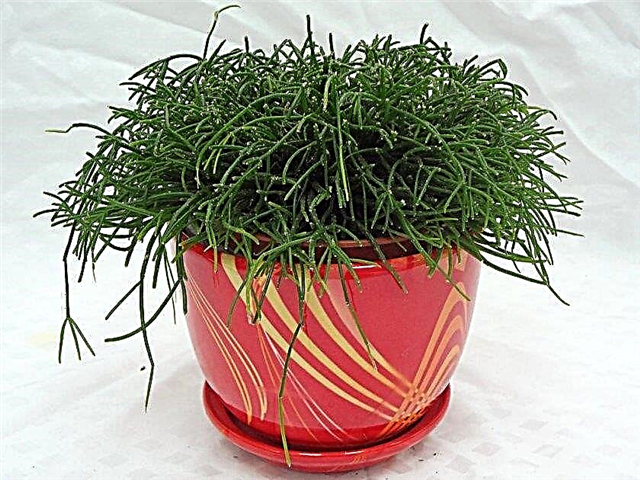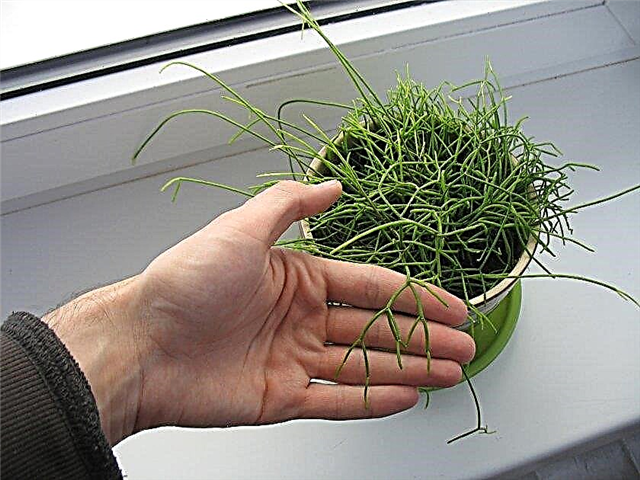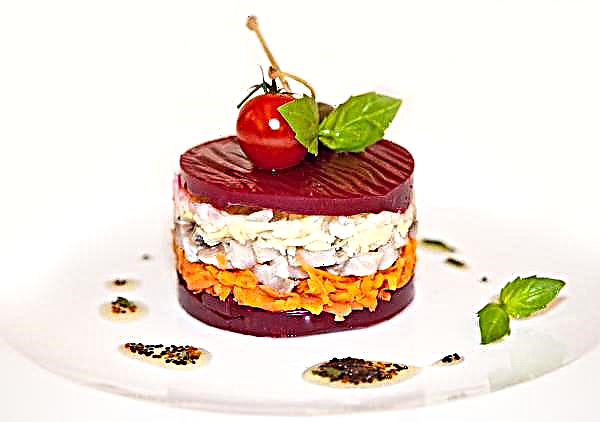Ripsalis flower is a tropical cactus that has long taken root in ordinary apartments as a houseplant. With good care, it quickly grows green and becomes an interior decoration.
Botanical description of the plant
This is a perennial plant with a small number of surface roots. In nature, this cactus often grows on trees, which saves it from excessive moisture. A set of elongated lobes of various shapes (cylindrical, flattened or ribbed) forms shoots that are covered with green skin. On some varieties areola covered with villi.
The shoots are combined into whorls, which form a fairly sweeping branch with a length of 70 cm to a meter. The width of one branch is up to 4 mm. When the plant is still young, its shape is similar to a specific bush, which grows over time and forms ampelous branches, on which aerial roots appear between the segments.
Ripsalis mix periodically throws bell-shaped inflorescences that form on the tops of shoots and areoles. The flower petals are arranged in several rows and have an oblong shape, narrow, and inside they have a bunch of stamens.
Flowers can be white, yellow and pink. Buds appear during the heat, in the tropics it is the period from October to January. After pollination, round-shaped berries appear in place of the flowers. Their skin is fleecy, and the berry itself is similar to gooseberries.
Did you know? The first mention of ripsalis was recorded in 1788 by the German botanist Joseph Gartner. He was impressed by the endurance of the plant and its ability to survive in difficult conditions.
Views
In nature, there are 60 species of this plant. Most of them are able to grow only in natural conditions, but some were able to get comfortable in ordinary apartments:
- Ripsalis Barcela. This species is characterized by narrow shoots of a cylindrical shape, the diameter of which is 2 cm, and their length is 6 cm. The color of the stems is dark green with white patches.

- Ripsalis hairy. The cactus consists of very thin and lush branches that tend to curl. Ripsalis shoots hang from a cache-pot, and by the end of autumn delight the eye with abundant flowering.

- Ripsalis conic. The shoots of this species resemble a bottle in shape. When the plant is still young, its stems are directed upwards, but as they grow, they lower and hang. One lash can grow up to a meter. The thickness of the stem is 3 mm, and the length of one segment is 5 cm.

- Ripsalis cassuta (empty). Cactus of green color. One branch may be 3 m in length. The shares are also quite large - from 10 to 50 cm. White small flowers appear at the extreme points of the shoots.

- Ripsalis pilocarp. This species is characterized by massive shoots, a large number of areoles that are covered with long yellow villi. The flowering period in him occurs 2-3 times a year. The flowers are yellow, inside there are long stamens, so the flower seems more fluffy.

- Ripsalis is elliptical. It has stems from 1 meter to two, the segments are flat and covered with areoles with a small pile. During flowering, this cactus releases buds on the sides of the lobes. The flowers themselves are yellow.

- Ripsalis prismatic. This variety produces several trunks, which can grow up to 15 cm. On their tops, prismatic segments are formed with the number of faces from 3 to 5. The flowers of this cactus are white.

- Ripsalis Cereusculus. It contains the main branches that extend from the center of the bush and grow to 10 cm. Lateral short segments depart from them - up to 1 cm. They form branches. Several new segments may grow from the ends of one branch.

Prerequisites and proper care
Caring for this flower will not take you much time. It is enough just to find a profitable place for ripsalis and periodically be interested in its condition.
Lighting
These plants feel good in bright light, but at the same time they can not be placed in direct sunlight. You can also put ripsalis at partial shade. In summer, it is best to keep the cactus in the fresh air, for example, on a balcony or porch, but in the shade.
Those types of ripsalis that are in the shape of a tree are better placed under the windowsill so that the branches can reach for the light, while it is necessary to organize supports for the shoots.
In order for plants to be comfortable living in your apartment, it is enough to install blinds on the windows.Important! It is not necessary to move the container with the cactus too often. From this, the plant experiences severe stress and loses its strength to adapt.
Temperature mode
It is necessary to contain a cactus in temperature conditions that resemble the thermal regime in its native latitudes, and this is a range from 18 to 22 degrees heat. In hot weather, it is necessary to ventilate the room more often or even take out the cactus in the air so that it can cool itself. He is not afraid of drafts, but a strong wind can injure fragile shoots.
In winter, the plant needs to be moved to a room where the temperature fluctuates between +10 ... + 15 degrees heat. But in no case should you supercool ripsalis.
Air humidity
Ripsalis does not require maintaining a certain level of humidity in the air. This plant adapts well to the conditions of the apartment. But if your cactus is too close to the radiator, then you need to periodically spray ripsalis with water. In addition, it is useful to wash the plant from time to time in the shower with warm water.
You can also provide ripsalis with sufficient moisture by simply placing the pot in a container with wet expanded clay or pebbles.
At home, succulents such as:
Watering
Water the cactus should be when the third part of the soil is already dry. This can be checked with an ordinary wooden stick, which you need to pierce the soil to the bottom of the pot and see how much earth has stuck to it.
Water needs to be poured out enough to wet the whole earth. When the plant does not bloom, then the frequency of watering is reduced. Water should be slightly warm and clean. For this, the liquid is settled or filtered.
Top dressing
During active growth, and this time from March to October, it is necessary to feed ripsalis with fertilizers for cacti every two weeks. Half of the dosage that is marked on the package will be enough for this species.
In the absence of specialized fertilizers, you can also take the usual floral, which you need to use half as much as indicated on the package.Important! In order not to provoke rotting of the roots of the succulent, you need to pay attention to the composition of the fertilizer. There should be a minimum of nitrogen.
From March to October, the plant is at rest, it is during this period that it is taken out to a cool place, and feeding is stopped.
Pruning
Pruning is optional, but if you want your succulent to look neater, it is best to do it in March. It is worth removing dry and damaged branches, as well as thinning them out a bit so that the plant can throw new shoots. Shorten the old stems three times.
Branches cannot be cut with sharp objects, instead you just need to unscrew the segment. During the formation of the plant, you can give it any shape.
Transfer
Ripsalis transplant is carried out after purchase. For the rest, this succulent should be transplanted only in case of urgent need. The thing is that fragile branches and roots are very easy to break.
The container for growing this cactus should be spacious and shallow. For this, a cache-pot and hanging pots are well suited.
The soil should be nutritious and contain many trace elements, and it is also not advisable to take acidic soil.You can prepare the soil yourself, for this you need to mix the following elements:
- sand;
- deciduous humus;
- turf land;
- peat.
Young succulents are recommended to be transplanted once a year, and already fairly grown up you can not touch 3 years. Older plants require an even less frequent change of pot, namely once every 4–5 years.
To prevent the appearance of diseases on ripsalis and infection of the soil, you can add a little charcoal to the soil.
Flowering and dormant period
From November to mid-March, ripsalis usually throws buds and pleases the eye with its flowering. For some, this period occurs only in adulthood, while others bloom every year. But there are those who do not bloom at all in an apartment.
During flowering, this cactus should not be rearranged or rotated, as it may lose buds. In addition, it is necessary to provide him with sufficient lighting, otherwise the extreme segments will also be discarded by the succulent.
From October to December, the plant is in a dormant period, so you need to provide it with moderate watering and an optimal temperature - from 15 to 20 degrees.
How to propagate at home
Ripsalis can be propagated in three ways, namely by cuttings, dividing the bush and planting seeds. Let's consider them in more detail:
- Cuttings. For this method of reproduction, you will need a segment of not young, but not the old shoot. It will be best to break it off rather than cut it off. Cuttings must be put in water so that they take root. You can also place them in loose wet soil, consisting of peat and sand. This "incubator" is covered with a film and placed in a room with a temperature of +23 to +25 degrees. But do not forget to ventilate the cuttings every day as condensation occurs on the film.

- Division. This can be done during transplantation. But you need to divide the bush as carefully as possible so as not to break the roots. Parts of the bush are planted in previously prepared containers with drainage at the bottom and a mixture of soil. After transplanting, it is necessary to water the cacti and put away from the sun.

- Planting seeds. Before planting, seeds must be sown in previously prepared special soil and maintained in a moist state. Shoots appear quite amicably. After the sprouts are sufficiently strong, they are usually planted in separate containers and placed at a temperature of +23 to +25 degrees Celsius.

Possible growing difficulties
Ripsalis is quite hardy and unpretentious, and also little susceptible to various diseases.
But sometimes with improper care or poor-quality soil, it can be prone to ailments:
- Chlorosis. This disease is manifested by yellowing and a decrease in leaves, which quickly fall off. At the same time, veins retain green color, while flowers and buds change their shape. The roots can die. In order to prevent the development of this disease, it is necessary to maintain the light regime for the plant and water it with a substrate with an acidity of pH from 5 to 5.5. Sometimes chlorosis occurs due to tap water, in this case it is necessary to periodically water the soil with a weak solution of citric acid. It is also necessary to add iron in chelated form to the soil. With this tool you need to process the leaves of a succulent.
Did you know? Thanks to the unusual shape of this plant, the British gave the flower a rather strange name - a cactus of dancing bones.
Shield. If this pest is wound up on a cactus, then first you should moisten a cotton swab in alcohol or soap solution and remove adult insects with it. After this, the plant must be washed in the shower and allowed to dry. The next step may be treatment with an insecticide, such as Fitoverm or Actellik. If there are too many insects, then this algorithm of actions needs to be repeated several times.

Spider mite. This pest attacks a cactus if the air humidity is not high enough, so when fighting an insect, you first need to increase moisture.
 To do this, it is best to wash the ripsalis with warm water and spray the air every day - this is a deadly medium for ticks, and the pests will quickly disappear. But sometimes, if the ticks are too prolific, this does not help. In this case, it is necessary to treat the succulent with special means - acaricides (Aktara, Kleschevit, Apollo).
To do this, it is best to wash the ripsalis with warm water and spray the air every day - this is a deadly medium for ticks, and the pests will quickly disappear. But sometimes, if the ticks are too prolific, this does not help. In this case, it is necessary to treat the succulent with special means - acaricides (Aktara, Kleschevit, Apollo).
This non-standard cactus will be able to please its beauty for a long time both during dormancy and during the period of abundant flowering. An unpretentious and fairly well adaptable indoor flower requires only a little attention and proper location from its owner.













 To do this, it is best to wash the ripsalis with warm water and spray the air every day - this is a deadly medium for ticks, and the pests will quickly disappear. But sometimes, if the ticks are too prolific, this does not help. In this case, it is necessary to treat the succulent with special means - acaricides (Aktara, Kleschevit, Apollo).
To do this, it is best to wash the ripsalis with warm water and spray the air every day - this is a deadly medium for ticks, and the pests will quickly disappear. But sometimes, if the ticks are too prolific, this does not help. In this case, it is necessary to treat the succulent with special means - acaricides (Aktara, Kleschevit, Apollo).










